
Saxe-Coburg and Gotha, or Saxe-Coburg-Gotha, was an Ernestine duchy in Thuringia ruled by a branch of the House of Wettin, consisting of territories in the present-day states of Thuringia and Bavaria in Germany. It lasted from 1826 to 1918. In November 1918, Charles Edward, Duke of Saxe-Coburg and Gotha, was forced to abdicate. In 1920, the northern part of the duchy was merged with six other Thuringian free states to form the Free State of Thuringia: Saxe-Weimar-Eisenach, Saxe-Altenburg and Saxe-Meiningen, Schwarzburg-Rudolstadt and Schwarzburg-Sondershausen, as well as the People's State of Reuss. The southern part of the duchy, as southernmost of the Thuringian states, was the only one which, after a referendum, became part of the Free State of Bavaria.

Ernest I served as the last sovereign duke of Saxe-Coburg-Saalfeld from 1806 to 1826 and the first sovereign duke of Saxe-Coburg and Gotha from 1826 to 1844. He was the father of Prince Albert, who was the husband of Queen Victoria. Ernest fought against Napoleon Bonaparte, and through construction projects and the establishment of a court theatre, he left a strong imprint on his residence town, Coburg.
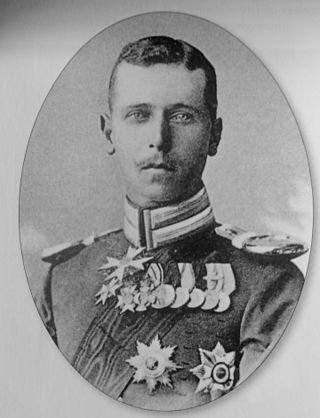
Alfred, Hereditary Prince of Saxe-Coburg and Gotha, was the son and heir apparent of Alfred, Duke of Saxe-Coburg and Gotha. He died aged 24 under circumstances still not entirely clear. He was a first cousin of Kaiser Wilhelm II of Germany, King George V of the United Kingdom and Tsar Nicholas II of Russia.
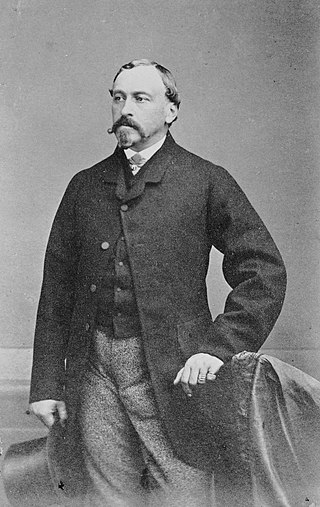
Ernest II was Duke of Saxe-Coburg and Gotha from 29 January 1844 to his death in 1893. He was born in Coburg to Ernest III, Duke of Saxe-Coburg-Saalfeld, and Princess Louise of Saxe-Gotha-Altenburg. His father became Duke of Saxe-Coburg and Gotha in 1826 through an exchange of territories.

Coburg is a town located on the Itz river in the Upper Franconia region of Bavaria, Germany. Long part of one of the Thuringian states of the Wettin line, it joined Bavaria by popular vote only in 1920. Until the revolution of 1918, it was one of the capitals of the Duchy of Saxe-Coburg and Gotha and the Duchy of Saxe-Coburg-Saalfeld.
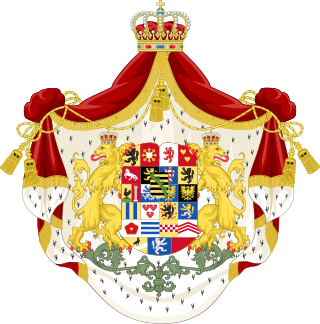
The House of Saxe-Coburg and Gotha is a European royal house. It takes its name from its oldest domain, the Ernestine duchy of Saxe-Coburg and Gotha, and its members later sat on the thrones of Belgium, Bulgaria, Portugal, and the United Kingdom and its dominions.
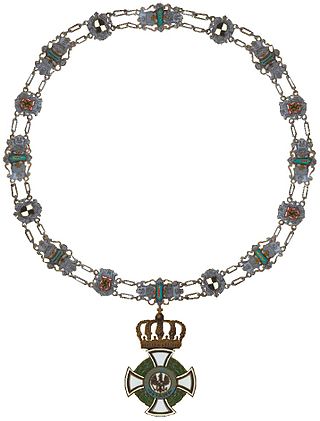
The House Order of Hohenzollern was a dynastic order of knighthood of the House of Hohenzollern awarded to military commissioned officers and civilians of comparable status. Associated with the various versions of the order were crosses and medals which could be awarded to lower-ranking soldiers and civilians.
Orders, decorations, and medals of the German Empire covers those decorations awarded by the states which came together under Prussian leadership to form the German Empire in 1871. For convenience's sake, this category also covers the decorations of the various German states which were no longer in existence in 1871, mainly because they had been annexed by Prussia during the Wars of Unification or before.

The House and Merit Order of Duke Peter Frederick Louis or proper German Oldenburg House and Merit Order of Duke Peter Frederick Louis was a civil and military order of the Grand Duchy of Oldenburg, a member state of the German Empire. The order was founded by Grand Duke Augustus of Oldenburg on 27 November 1838, to honor his father, Peter Frederick Louis of Oldenburg. It became obsolete in 1918 after the abdication of the last grand duke.

The Military Order of St. Henry was a military order of the Kingdom of Saxony, a member state of the German Empire. The order was the oldest military order of the states of the German Empire. It was founded on October 7, 1736 by Augustus III, King of Poland and Elector of Saxony. The order underwent several more revisions over the course of the 19th and early 20th centuries. It became obsolete with the fall of the Saxon monarchy in the wake of Germany's defeat in World War I.
Ernst Leopold Eduard Wilhelm Josias Prinz von Sachsen-Coburg und Gotha was the second child and eldest son of Johann Leopold, Hereditary Prince of Saxe-Coburg and Gotha and Feodora Freiin von der Horst.
Prince Hubertus of Saxe-Coburg and Gotha was a German courier pilot and a member of the House of Saxe-Coburg-Gotha, which reigned over the eponymous duchy in the German Empire. Born a prince of Great Britain and Ireland as a great-grandson of Queen Victoria, Hubertus lost this title during the First World War. He became heir apparent to the headship of his house in 1932. Secretly homosexual, he never married. Hubertus joined the Nazi Party upon the outbreak of the Second World War despite his opposition to Adolf Hitler and Nazism. He served in the Luftwaffe on the Eastern Front until he was killed in action.
Hubertus Prinz von Sachsen-Coburg und Gotha is the eldest son of Ernst-Leopold Prinz von Sachsen-Coburg und Gotha and his first wife, Ingeborg Henig.

The Order of the Cross of Takovo was a Serbian state order.
Events in the year 1898 in Germany.
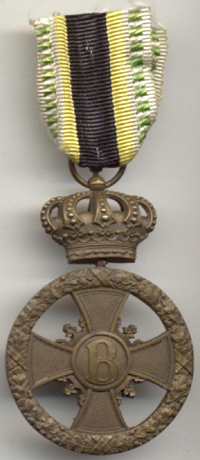
The Cross for Merit in War was a military decoration of the Duchy of Saxe-Meiningen established by Bernhard III, Duke of Saxe-Meiningen on 7 March 1915.

Callenberg Castle is a schloss on a wooded hill in Beiersdorf, an Ortsteil of Coburg, Germany, 6 kilometres (3.7 mi) from the town centre. It was a hunting lodge and summer residence and has long been the principal residence of the House of Saxe-Coburg and Gotha. It is currently owned by Andreas, Prince of Saxe-Coburg and Gotha, who created the Ducal Saxe-Coburg and Gotha House Order. A large and architecturally important family chapel is contained within.

The House Order of Henry the Lion In German: Hausorden Heinrichs des Löwen, was the House Order of the Duchy of Brunswick. It was instituted by William VIII, Duke of Brunswick on 25 April 1834. The ribbon of the Order was red with yellow edges. It had five grades: Grand Cross, Grand Commander with Sash, Commander, Knight 1st Class, Knight 2nd Class, plus Medal of Merit for Science and Arts, the Cross of Merit and the Medal of Honour. The Order was named in honour of Henry the Lion, who remains a popular figure to this day.

The Order of Merit of Philip the Magnanimous was an order of chivalry established by Louis II, Grand Duke of Hesse on 1 May 1840, the name day of Philip I, Landgrave of Hesse, in his honour to award extraordinary military or civil merit. It was the second-highest order of the Grand Duchy of Hesse before 1876, when it was displaced to third by the revived Order of the Golden Lion, the former paramount order of the Electorate of Hesse.
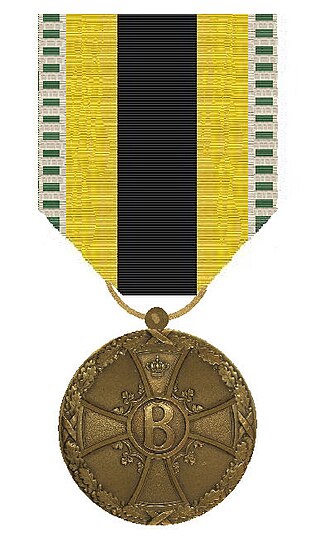
The Medal for Merit in War was a military decoration of the Duchy of Saxe-Meiningen, established during World War I on 7 March 1915 by Bernhard III, Duke of Saxe-Meiningen. For officers, there was the Cross for Merit in War, while the Medal was for enlisted personnel.
















